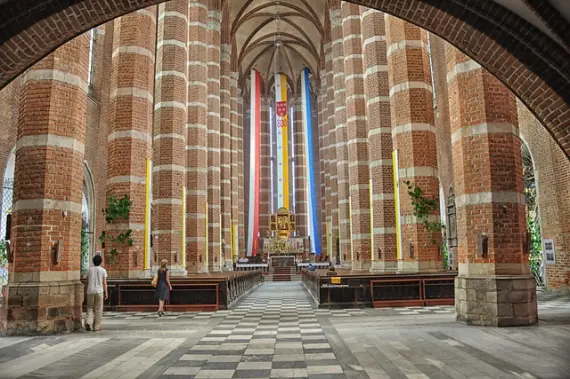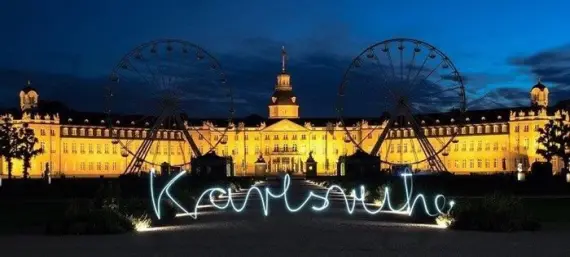How to travel from NYSA to KARLSRUHE?
NYSA

Nysa is a city of more than 40,000 people in Opolskie province. It is located on the border of the Sudetic Foothills and the Silesian Lowlands, in the southwestern part of the Nysa Klodzka Valley.
Nysa - monuments in the city
Despite a lot of war damage and the demolition of more than a hundred historic houses in the 1950s, Nysa has many valuable buildings. In particular, it is worth seeing the old town with its market square, where the noteworthy landmarks are the House of the Town Scales and the town hall with its recently added tower, which can be reached by a high-speed elevator. The Beautiful Well and the Triton Fountain are also valuable monuments there.
Nysa also boasts a multitude of churches and other religious buildings. For this reason it is called "Silesian Rome." The most valuable temple distinguished by its large, sloping roof is the Basilica of St. James and St. Agnes, located on the market square. Right next to it is the Treasury of St. James, a gallery with works of sacred art created in a free-standing 16th-century bell tower.
Nysa - restaurants where to eat
The city has a rich and very diverse gastronomic offer. You will find great Armenian cuisine, Croatian cuisine, but of course also tasty home-cooked dinners and burgers and Italian pizzas so popular in Poland.
Getting there
Nysa is located at the crossroads of many transportation routes, which provides convenient connections to cities in Lower and Upper Silesia, as well as the Czech Republic. Nysa's train station and bus station are located next to each other in the city center, on Raclawicka Street. You can visit this city using the bus connections we offer. If you are curious about the sights that Nysa has to offer, the bus will be a good and affordable means of transportation for you. You can buy tickets to Nysa from many cities in Poland on our website.
Nysa is a city of more than 40,000 people in Opolskie province. It is located on the border of the Sudetic Foothills and the Silesian Lowlands, in the southwestern part of the Nysa Klodzka Valley.
Nysa - monuments in the city
Despite a lot of war damage and the demolition of more than a hundred historic houses in the 1950s, Nysa has many valuable buildings. In particular, it is worth seeing the old town with its market square, where the noteworthy landmarks are the House of the Town Scales and the town hall with its recently added tower, which can be reached by a high-speed elevator. The Beautiful Well and the Triton Fountain are also valuable monuments there.
Nysa also boasts a multitude of churches and other religious buildings. For this reason it is called "Silesian Rome." The most valuable temple distinguished by its large, sloping roof is the Basilica of St. James and St. Agnes, located on the market square. Right next to it is the Treasury of St. James, a gallery with works of sacred art created in a free-standing 16th-century bell tower.
Nysa - restaurants where to eat
The city has a rich and very diverse gastronomic offer. You will find great Armenian cuisine, Croatian cuisine, but of course also tasty home-cooked dinners and burgers and Italian pizzas so popular in Poland.
Getting there
Nysa is located at the crossroads of many transportation routes, which provides convenient connections to cities in Lower and Upper Silesia, as well as the Czech Republic. Nysa's train station and bus station are located next to each other in the city center, on Raclawicka Street. You can visit this city using the bus connections we offer. If you are curious about the sights that Nysa has to offer, the bus will be a good and affordable means of transportation for you. You can buy tickets to Nysa from many cities in Poland on our website.
KARLSRUHE

Karlsruhe is a city in Baden-Württemberg in southwestern Germany. It lies in the Upper Rhine Plain, on the Rhine, Alb and Pfinz rivers. It was founded in 1715 by the Margrave of Baden, Karl Wilhelm von Baden-Durlach. What undoubtedly distinguishes the city is its layout in the classic star-shaped layout. At the center is the palace, from which 32 avenues descend radially.
Already in the 19th century Karlsruhe was an important European scientific center. Research on electromagnetic waves was conducted there by Heinrich Hertz, and Karl Drais constructed the first bicycle in 1817. The city is home to Germany's oldest technical university.
What to see in Karlsruhe?
One of the most important sights in the city is the Renaissance palace located in the center. Its interiors now house the Baden State Museum with collections on the region and Karlsruhe itself. This castle is surrounded by an extensive park with a botanical garden and other thematic gardens, where you can have a nice rest amidst the greenery. Another museum worth visiting is the Staatliche Kunsthalle Karlsruhe, with a valuable collection of paintings by such famous artists as Rembrandt, Dürer and Cézanne, among others.
Getting there and transportation - Karlsruhe
The city is well connected - important highways such as the A5, A8 and A65 pass close by, and the French border is only about twenty kilometers away. Karlsruhe's location on the Rhine makes the city an important inland port, the fourth largest in Germany.
The city is also a major rail hub with a freight station where numerous lines converge, including those from Heidelberg to Basel and Mannheim to Rastatt. The Karlsruhe bus station is located near the city's main train station - Karlsruhe Hauptbahnhof on Schwarzwaldstrsse. Sindbad offers numerous buses to Karlsruhe - an affordable and environmentally friendly option for getting to this German city.
Karlsruhe is a city in Baden-Württemberg in southwestern Germany. It lies in the Upper Rhine Plain, on the Rhine, Alb and Pfinz rivers. It was founded in 1715 by the Margrave of Baden, Karl Wilhelm von Baden-Durlach. What undoubtedly distinguishes the city is its layout in the classic star-shaped layout. At the center is the palace, from which 32 avenues descend radially.
Already in the 19th century Karlsruhe was an important European scientific center. Research on electromagnetic waves was conducted there by Heinrich Hertz, and Karl Drais constructed the first bicycle in 1817. The city is home to Germany's oldest technical university.
What to see in Karlsruhe?
One of the most important sights in the city is the Renaissance palace located in the center. Its interiors now house the Baden State Museum with collections on the region and Karlsruhe itself. This castle is surrounded by an extensive park with a botanical garden and other thematic gardens, where you can have a nice rest amidst the greenery. Another museum worth visiting is the Staatliche Kunsthalle Karlsruhe, with a valuable collection of paintings by such famous artists as Rembrandt, Dürer and Cézanne, among others.
Getting there and transportation - Karlsruhe
The city is well connected - important highways such as the A5, A8 and A65 pass close by, and the French border is only about twenty kilometers away. Karlsruhe's location on the Rhine makes the city an important inland port, the fourth largest in Germany.
The city is also a major rail hub with a freight station where numerous lines converge, including those from Heidelberg to Basel and Mannheim to Rastatt. The Karlsruhe bus station is located near the city's main train station - Karlsruhe Hauptbahnhof on Schwarzwaldstrsse. Sindbad offers numerous buses to Karlsruhe - an affordable and environmentally friendly option for getting to this German city.
© 2025 Sindbad
Technical support, assistance, payments: Sindbad IT
© 2025 Sindbad
Technical support, assistance, payments: Sindbad IT
